This book constitutes the refereed proceedings of the 16th International Conference on Data Warehousing and Knowledge Discovery, DaWaK 2014 held in Munich, Germany, September 2014, in conjunction with DEXA 2014. The 34 revised full papers and 8 short papers presented were carefully reviewed and selected from 109 submissions. The papers are organized in topical sections on modeling and ETL; ontology-based data warehouses; advanced data warehouses and OLAP; uncertainty; preferences and recommendation; query performance and HPC; cube & OLAP; optimization; classification; social networks and recommendation systems; knowledge data discovery; industrial applications; mining and processing data stream; mining and similarity.
